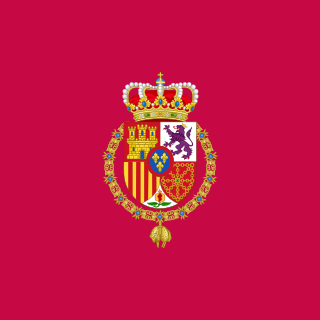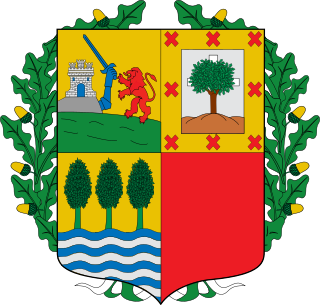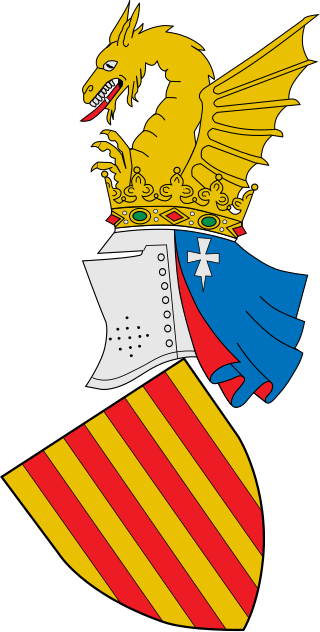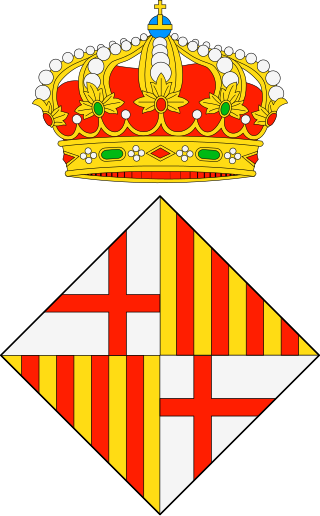
The coat of arms of the Argentine Republic or Argentine shield was established in its current form in 1944 but has its origins in the seal of the General Constituent Assembly of 1813. It is supposed that it was chosen quickly because of the existence of a decree signed on February 22 sealed with the symbol. The first mention of it in a public document dates to March 12 of that same year, in which it is stated that the seal had to be used by the executive power, that is, the second triumvirate. On April 13 the National Assembly coined the new silver and gold coins, each with the seal of the assembly on the reverse, and on April 27 the coat of arms became a national emblem. Although the coat of arms is not currently shown on flags, the Buenos Aires-born military leader Manuel Belgrano ordered to paint it over the flag he gave to the city of San Salvador de Jujuy, and during the Argentine War of Independence most flags had the coat of arms.

The national flag of Spain, as it is defined in the Constitution of 1978, consists of three horizontal stripes: red, yellow and red, the yellow stripe being twice the height of each red stripe. Traditionally, the middle stripe was defined by the more archaic term of gualda, and hence the popular name la Rojigualda (red-weld).

The coat of arms of the King of Spain is the heraldic symbol representing the monarch of Spain. The current version of the monarch's coat of arms was adopted in 2014 but is of much older origin. The arms marshal the arms of the former monarchs of Castile, León, Aragon, and Navarre.

The President of the Principality of Asturias ; Asturian: Presidente del Principáu d'Asturies) is the head of government of the Spanish autonomous community of Asturias. The president is chosen by the General Junta of the Principality of Asturias, autonomous parliamentary institution.

The Royal Standard of Spain is the official flag of the King of Spain. It comprises a crimson square, traditional colour of both Castilian and Spanish monarchs, with the coat of arms of the King in the center. It is raised over the official royal residence in Madrid, the Palacio de la Zarzuela and other Spanish royal sites, when the monarch is in residence and displayed on his official car as small flag. The current flag was adopted when Felipe VI acceded the throne as King of Spain on 19 June 2014. The Royal Standard is regulated by Rule 2 of Royal Decree 527/2014, 20 June, an amendment to Title II of Spanish Royal Decree 1511/1977 adopting Flags, Standards, Guidons, Insignia and Emblems Regulation.

The current Basque coat of arms is the official coat of arms of the Basque Country, Autonomous community of Spain. It consists of a party per cross representing the three historical territories of Álava, Gipuzkoa and Biscay, as well as a fourth, void quarter. The arms are ringed by a regal wreath of oak leaves, symbolic of the Gernikako Arbola. The fourth quarter constituted since the late 19th century the linked chains of Navarre; however, following a legal suit by the Navarre Government claiming that the usage of the arms of a region on the flag of another was illegal, the Constitutional Court of Spain ordered the removal of the chains of Navarre in a judgement of 1986.

The coat of arms of the Valencian Community is the official emblem of the self-government institutions of the Valencian Community. It is based on the armorial achievement used from the reign of King Peter IV to John II, called the Great. In 1978 the former Council of the Valencian Country approved it “...for being the oldest known representative emblem of the former Kingdom of Valencia, that had located on the Xerea Gate of the city of Valencia”.

The Cross of the Angels is a pre-romanesque Asturian reliquary donated by Alfonso II of Asturias in the year 808 to the Church of San Salvador in Oviedo, Asturias (Spain). The Cross of the Angels is the symbol of the city of Oviedo.

The 2015 Asturian regional election was held on Sunday, 24 May 2015, to elect the 10th General Junta of the Principality of Asturias. All 45 seats in the General Junta were up for election. Because regional elections in the Principality of Asturias were mandated for the fourth Sunday of May every four years, the 2012 snap election did not alter the term of the four-year legislature starting in 2011. The election was held simultaneously with regional elections in twelve other autonomous communities and local elections all throughout Spain.

The 1983 Asturian regional election was held on Sunday, 8 May 1983, to elect the 1st General Junta of the Principality of Asturias. All 45 seats in the General Junta were up for election. The election was held simultaneously with regional elections in twelve other autonomous communities and local elections all throughout Spain.

The 1987 Asturian regional election was held on Wednesday, 10 June 1987, to elect the 2nd General Junta of the Principality of Asturias. All 45 seats in the General Junta were up for election. The election was held simultaneously with regional elections in twelve other autonomous communities and local elections all throughout Spain, as well as the 1987 European Parliament election.

The 2003 Asturian regional election was held on Sunday, 25 May 2003, to elect the 6th General Junta of the Principality of Asturias. All 45 seats in the General Junta were up for election. The election was held simultaneously with regional elections in twelve other autonomous communities and local elections all throughout Spain.

The 2019 Asturian regional election was held on Sunday, 26 May 2019, to elect the 11th General Junta of the Principality of Asturias. All 45 seats in the General Junta were up for election. The election was held simultaneously with regional elections in eleven other autonomous communities and local elections all throughout Spain, as well as the 2019 European Parliament election.

The coat of arms of Barcelona is the official emblem of the City Council of Barcelona, the capital of Catalonia, has its origin in the Middle Ages, these arms were first documented in 1329. The Government of Catalonia conferred the coat of arms and the flag as official symbols of the municipality in 2004. It has an escutcheon in lozenge which is commonly used in municipal coats of arms of cities in Catalonia. Currently the City Council of Barcelona also uses an isotype based on the heraldry of the city.
This is the results breakdown of the local elections held in Asturias on 25 May 2003. The following tables show detailed results in the autonomous community's most populous municipalities, sorted alphabetically.
This is the results breakdown of the local elections held in Asturias on 22 May 2011. The following tables show detailed results in the autonomous community's most populous municipalities, sorted alphabetically.
This is the results breakdown of the local elections held in Asturias on 24 May 2015. The following tables show detailed results in the autonomous community's most populous municipalities, sorted alphabetically.

The first government of Adrián Barbón was formed on 25 July 2019, following the latter's election as President of the Principality of Asturias by the General Junta of the Principality of Asturias on 15 July and his swearing-in on 17 July, as a result of the Spanish Socialist Workers' Party (PSOE) emerging as the largest parliamentary force at the 2019 regional election. It succeeded the second Fernández government and was the incumbent Government of the Principality of Asturias between 25 July 2019 and 31 July 2023, a total of 1,467 days, or 4 years and 6 days.
The Medal of the Principality of Asturias is a Spanish civil decoration, the highest distinction awarded by the autonomous community of Asturias. Its purpose is to reward merits considered truly unique, carried out by both individuals and entities recognized for having provided services or activities of various nature for the benefit of the general interests of the Principality of Asturias. It is described in Law 4/1986, of 15 May, regulating honors and distinctions, published in the Boletín Oficial del Principado de Asturias number 125 on 30 May 1986. This rule replaced the regulations for the granting of honors and distinctions of the former Provincial Council of Asturias, of 29 October 1970. The medal has two different categories: gold and silver.

The 2023 Asturian regional election was held on Sunday, 28 May 2023, to elect the 12th General Junta of the Principality of Asturias. All 45 seats in the General Junta were up for election. The election was held simultaneously with regional elections in eleven other autonomous communities and local elections all throughout Spain.


















